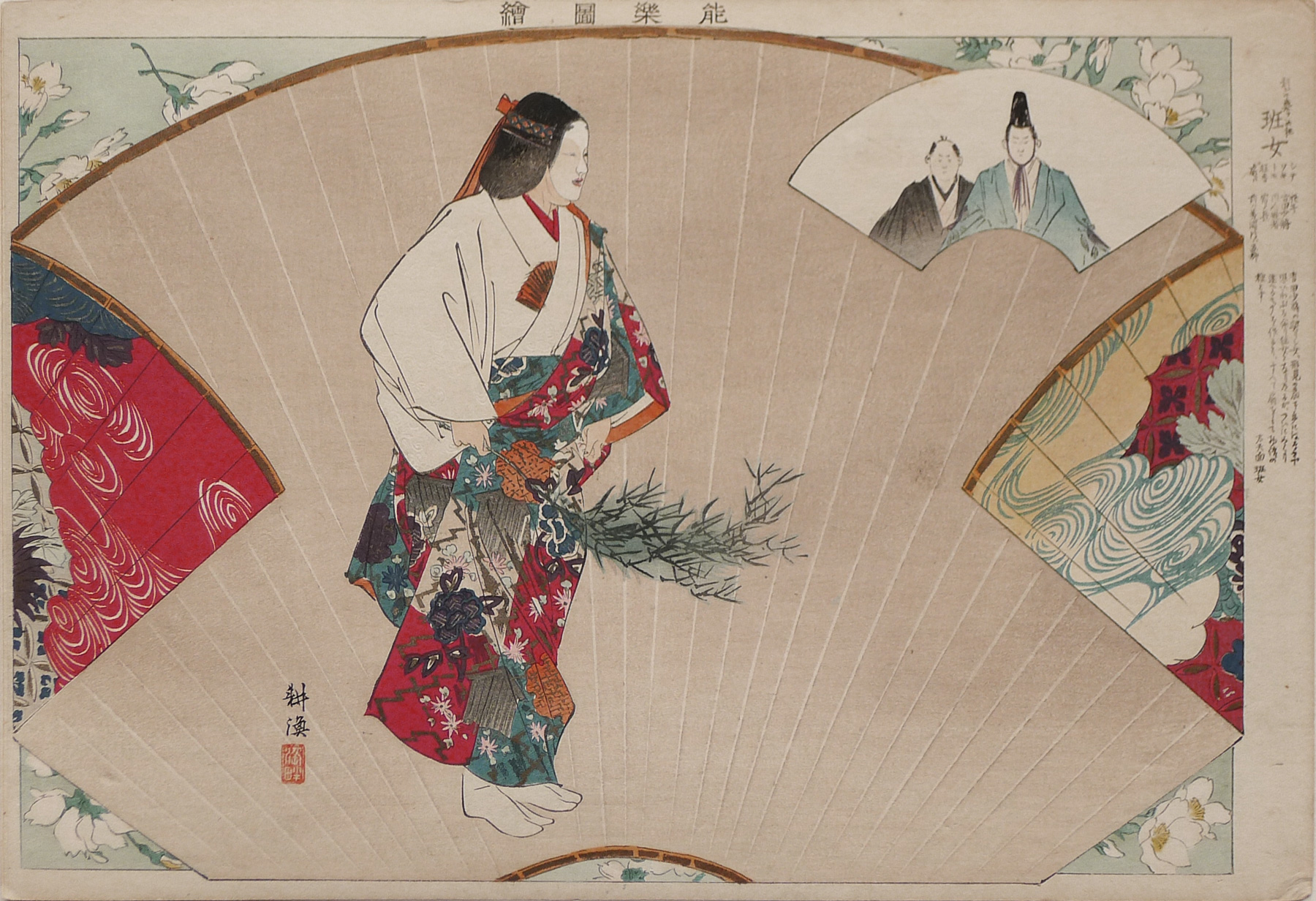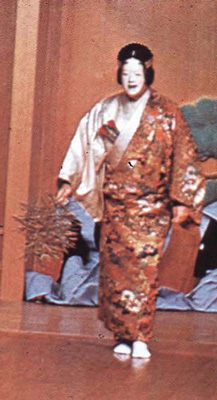About This Print
One of 261 prints from the series Nōgakuzue (Illustrations of Noh). The print depicts a scene from the Noh play Hanjo (The Girl Whose Lover Went Away), attributed to the playwright Zeami Motokiyo (1363-1443), in which Hanjo searches for her lover.
For background on the Noh theater see the article on this site "Noh - A Brief Summary by Beata Kubiak Ho-Chi".
The Play - Hanjo
Source: Scripps College Ruth Chandler Williamson Gallery website http://web-kiosk.scrippscollege.edu/Obj20860
In this play, two lovers are forced to part. They exchange fans, representing the promise of their future reunion. Hanago soon becomes heart-stricken and can do nothing more but look longingly at the fan that her lover has left behind. Thus she is nicknamed Hanjo, a name taken from the Chinese story about Han Shoyo. According to the Chinese story, when Han Shoyo was replaced by another woman as the emperor’s favorite, she wrote a poem comparing herself to a fan: once treasured during summer, the fan is quickly abandoned in autumn. This print depicts Hanjo’s lonely, passionate, and even obsessive search for her lost love. At the end of the play, Hanjo’s lover identifies her by the fan that she has placed inside her robe and over her heart. They are once again united.Source: A Guide to No, P.G. O'Neill, Hinoki Shoten, 1929, p. 50-51.
A woman in charge of an inn at Nogami in the province of Mino complains that since Hanago, one of the girls there, formed an attachment with Yoshida no Shōshō when he passed through there in the spring, she has refused to wait on other guests. She therefore calls Hanago to her and tells her that she must leave. Thus, when Yoshida calls at Nogami for her on his way back to the capital, he finds her gone. Sadly returning to the capital alone, he goes straight to the Shimo-Kamo Shrine to pray that they may meet again, and while he is there a mad woman comes and dances. As she does so, Yoshida notices her fan and, sending his servant to bring it to him, finds that it is the one which he gave to Hanago in exchange for hers as a token of his love, and that the woman is indeed Hanago. He then shows here the fan he carries and the two are happily reunited.
For more details of this play see the-NOH.com website http://www.the-noh.com/en/plays/data/program_034.html
Noh performance of Hanjo
Copyright 1998-2008, Global Performing Arts Consortium. Courtesy of Karen Brazell; All Rights Reserved.
Copyright 1998-2008, Global Performing Arts Consortium. Courtesy of Karen Brazell; All Rights Reserved.
Right Margin Description of Scene
click on image to enlarge
Print Details
| IHL Catalog | #887 |
| Title | Hanjo 班女 (The Girl Whose Lover Went Away or Fan of the Lost Lover) |
| Series | Nōgakuzue 能樂圖繪 (Illustrations of Noh) |
| Artist | Tsukioka Kōgyo (1869-1927) |
| Signature |  |
| Seal |  |
| Date | Date is trimmed from this print. Ritsumeikan ARC gives the dates of printing and issuance of their print (arcUP0840), as follows: September 10, 1898 (Meiji 31) 明治三十一年九月十日印刷仝年仝月廿日発行 Date of printing: September 10, 1898 Date of issuance: September 20, 1898 |
| Edition | unknown |
| Publisher | Matsuki Heikichi (Daikokuya Heikichi 大黒屋平) [Marks: pub. ref. 029] (note: left margin which normally contains the publisher's information is trimmed on this print.) |
| Carver | |
| Impression | excellent |
| Colors | excellent |
| Condition | good - backed by heavy paper; left margin trimmed |
| Genre | ukiyo-e |
| Miscellaneous | silver metallic highlights and embossing on robe and gold metallic highlights on fan border |
| Format | oban yoko-e |
| H x W Paper | 9 1/2 x 14 in. (24.1 x 35.6 cm) |
| H x W Image | 8 3/4 x 12 7/8 in. (22.2 x 32.7 cm) area within printed black border |
| Collections This Print | Art Institute of Chicago 1939.2258.67 (titled "Banjo"); Art Research Center, Ritsumeikan University AcNo.arcUP0910; University of Pittsburgh 20091209-kogyo-0234 |
| Reference Literature |




